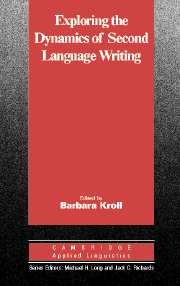Book contents
- Frontmatter
- Contents
- List of contributors
- Acknowledgments
- List of abbreviations used
- Series editors' preface
- Introduction: Teaching the next generation of second language writers
- I EXPLORING THE FIELD OF SECOND LANGUAGE WRITING
- II EXPLORING THE VOICES OF KEY STAKEHOLDERS:TEACHERS AND STUDENTS
- III EXPLORING WRITERS' FINISHED TEXTS
- IV EXPLORING CONTEXTUALITIES OF TEXTS
- V EXPLORING TECHNOLOGY
- EPILOGUE: EXPLORING OURSELVES
- Index
Series editors' preface
Published online by Cambridge University Press: 05 October 2012
- Frontmatter
- Contents
- List of contributors
- Acknowledgments
- List of abbreviations used
- Series editors' preface
- Introduction: Teaching the next generation of second language writers
- I EXPLORING THE FIELD OF SECOND LANGUAGE WRITING
- II EXPLORING THE VOICES OF KEY STAKEHOLDERS:TEACHERS AND STUDENTS
- III EXPLORING WRITERS' FINISHED TEXTS
- IV EXPLORING CONTEXTUALITIES OF TEXTS
- V EXPLORING TECHNOLOGY
- EPILOGUE: EXPLORING OURSELVES
- Index
Summary
Whereas it is commonplace to talk of English as the language of globalization and international communication, it is appropriate to recognize that it is written English that is the predominant medium for much of this discourse. Second language writing skills play an increasingly important role today in the lives of professionals in almost every field and discipline, creating a challenge to those responsible for the teaching of second language writing. The growing body of research by scholars in the field of second language writing instruction reflects an international response to this phenomenon, much of the results of which are reflected in the present volume.
Exploring the Dynamics of Second Language Writing is a timely collection of original papers surveying theory, research, and practice in the teaching of second language writing. Each of the chapters provides a useful overview of a key topic in second language writing, identifying the major theoretical issues, surveying research findings, and exploring applications to second language teaching.
The book is based on several assumptions:
The field of second language (L2) writing is an autonomous discipline, though one that draws on a number of related fields, including composition studies, rhetoric, contrastive rhetoric, text linguistics, and genre theory.
There is a demand today for teachers with a high level of pedagogical understanding and expertise in the different aspects of writing instruction, from curriculum development, to classroom pedagogy, to assessment.
[…]
Information
- Type
- Chapter
- Information
- Exploring the Dynamics of Second Language Writing , pp. xv - xviPublisher: Cambridge University PressPrint publication year: 2003
